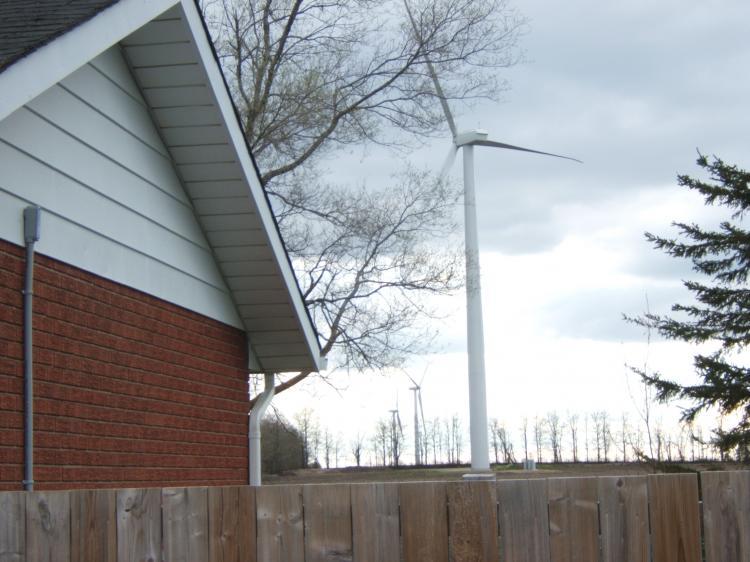There’s a boom in wind energy occurring worldwide. Keen to meet environmental targets and cut back on fossil fuels, governments in Europe, North America, Australia, and Japan are increasingly looking to wind as a source of power.
In Canada, wind turbines have become part of the landscape in many rural areas, with Ontario, Alberta, and Quebec leading the way in setting ambitious targets for future production of wind power.
From the Maritimes to Alberta, there are about 1,500 turbines powering almost 700,000 homes and businesses, with plans in the works to build another 1,000 to 1,500 in the next year, including in British Columbia where none currently exist.
But as wind farms proliferate, so do complaints about them. While some people experience no negative effects whatsoever, others have even resorted to leaving their homes to get away from the windmills they claim are making them sick.
While research into the problem is lacking, some who live near the big turbines cite a raft of adverse health effects, including severe headaches, insomnia, dizziness, ringing in the ears, exhaustion, and even blood pressure and heart problems.
Glen Wylds says he and 11 of his neighbours who live in the Ripley wind turbine complex in Ontario have been afflicted with a wide range of serious symptoms since soon after the hydro configuration to their homes was changed in November 2007. This was done to collect the electricity generated by the 38 turbines surrounding their homes.
Wylds’ first symptom was severe itch, while his wife “just kept getting sicker and sicker.” The couple began experiencing intense headaches and earaches, with their hearts “pounding something awful,” says Wylds. Their two dogs developed ear problems and lost their hair.
The problem was traced to stray voltage—electrical pollution from the high-voltage wind turbine lines—invading their homes.
Acciona Energy and Suncor Energy Products, the companies that own the Ripley complex, buried some of the power lines but the problems continued. Wylds says the company billeted some families in motels in nearby Kincardine, but when they returned to their homes their symptoms reappeared.
Having had enough, Wylds eventually bought a house in Kincardine, but he needs to regularly return to Ripley to tend his herd of 500 cattle. As soon as he sets foot in the house, he says, his symptoms return.
He says his doctor has advised him not to return to the house, which he moved into in 1973 and where he planned to live out his old age.
Studies Show No Link
Wind energy advocates say studies show no proof that turbines cause health problems and that residents who live near wind farms have few complaints about them.
Sean Whittaker, VP of policy for the industry-affiliated Canadian Wind Energy Association, says he’s aware of claims that turbines cause health problems for some people, but several studies have produced no evidence that this is the case.
“It’s hard to say why these things are happening. It’s certainly of concern, but you do have to look at the peer-reviewed research that’s been done on the subject and what that tells you.”
Whittaker cites in particular a comprehensive study commissioned by the British government which looked into the low-frequency sound produced by turbines that many suspect is having an impact on their health. The study found that turbines can’t produce infrasound at levels that affect humans.
He says polls show 87 percent of people agree with having more wind turbines, and that figure rises to 97 percent for those living within one kilometre of a wind farm.
“It’s important to point out that worldwide there’s something like 30 or 40,000 turbines,” Whittaker says. “People have been living around wind turbines for a very long time. In places like California, Denmark, and Germany, people have lived around them for 15 to 20 years and more. Complaints about the turbines are very few and far between.”
One of the few provinces with regulations governing wind farms, Ontario requires a noise-impact assessment for buildings up to 1,000 metres from a turbine.
‘Quit putting them so close to houses’
For Barbara Ashbee it was the noise that became a problem after phase two of the Melancthon/Amaranth wind farm went into operation near her home in rural Ontario in December 2008. Since then she and her husband have been plagued with insomnia.
“The noise coming off them was just horrendous, depending on the speed of the wind, the direction, and the atmosphere. When it all started I had three nights straight of absolutely zero sleep, it was just horrible. Even our dog was upset,” says Ashbee.
After several noise studies were conducted, it was discovered that most of the noise was coming from a turbine that had been built just 457 metres from Ashbee’s home. Eventually the company that owns the 133-turbine complex agreed to turn off that turbine permanently, while five others are turned off at night.
Although this has helped, Ashbee says a constant “hum-vibration” that varies in intensity continues to cause insomnia, fatigue, and ringing in the ears for her and her husband. She says tests show that the house is also contaminated with stray voltage.
Health problems became so severe for Helen and Bill Fraser, who were residents in the same complex, that they sold the home they’d lived in for 30 years and moved to a nearby town.
“People are being forced out of their homes,” Ashbee says. “[The turbines] are just too close to the residences, that’s all there is to it. They’ve got to quit putting them so close to houses.”
The issue of setbacks has become a bone of contention in many countries. Critics say wind turbines are allowed to be sited too close to homes or where people congregate.
Nina Pierpont, a U.S. physician and scientist and author of Wind Turbine Syndrome, said in her testimony before the New York State Legislature Energy Committee that turbines shouldn’t be sited any closer than 1.25 miles (2 km) from buildings.
In hilly or mountainous terrain, where valleys act as natural channels for noise, she said the setback should be as much as three miles.
“I would like to stress that these are not ‘farms.’ One doesn’t ‘farm’ wind any more than one ‘farms’ water in a hydroelectric dam or ‘farms’ neutrons in an atomic plant. These are large, industrial installations. They make large-scale, industrial noise,” said Pierpont.
Need for Standards, Public Health Research
Carmen Krogh, a retired Alberta pharmacist, says she never gave wind turbines a second thought until she vacationed near a wind farm in 2005. When the blades were still she was fine, but when the wind picked up and the blades began turning she says she experienced a number of worrisome symptoms.
“I got this sensation that others have recorded—this vibration in my body. It was very disconcerting, and the vibration in my heart felt like my heartbeat being changed…. I had a terrible headache and I had vertigo, like a kind of nausea,” she says.
Krogh, who has been involved in healthcare for over 40 years, linked her reaction to the turbines, left the area, and her symptoms subsided within a few days, she says.
In 2008 she began researching the issue, something she felt qualified to do having run the drug information pharmacy at Ottawa General Hospital where she researched drug therapies and advised doctors.
A survey Krogh conducted on six Ontario windmill complexes found that 53 of 76 residents said they suffered adverse health effects from the turbines, including sleep disturbances, headaches, and depression.
Krogh believes that in the rush to convert to wind power as part of its Green Energy Act, the Ontario government “let wind turbines come into the province without doing their homework … in spite of all the references and the health concerns out there.”
Ontario Premier Dalton McGuinty said in April that he would look into setting standards to deal with low-frequency sound waves and address health concerns regarding wind turbines.
McGuinty said he had spoken with Dr. Robert McMurtry, a former dean of medicine at the University of Western Ontario. McMurtry wants the government to conduct more studies in order to determine the turbines’ impact on human health.
Thirty Ontario municipalities have called on the provincial government to do a comprehensive health study.
Krogh says there needs to be an epidemiological study—“the holy grail for public health research”—undertaken to identify the risks and provide guidelines for the medical community.
As for Glen Wylds, he’s worried about his son, his son’s pregnant girlfriend, and their two-year-old daughter who continue to live at the Ripley complex. He says their daughter constantly wakes up at night screaming with earaches, and the family has made many frantic visits to the emergency ward.
Meanwhile he’s stuck with a house he can neither live in nor sell.
“That was our home, it was our livelihood. I had no intention of ever leaving. I wasn’t against the wind farms coming—I never complained about nothing. Everybody was reassured that we would have no problems. This is just like something you see on TV that happens to somebody else.”







